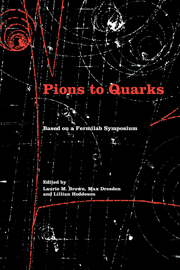Book contents
- Frontmatter
- Contents
- List of contributors
- Foreword by Leon M. Lederman
- Editors' acknowledgments
- Photographs of the symposium
- List of abbreviations
- List of notation
- I Introduction
- II Particle discoveries in cosmic rays
- III High-energy nuclear physics
- IV The new laboratory
- V The strange particles
- 19 The hydrogen bubble chamber and the strange resonances
- 20 A particular view of particle physics in the fifties
- 21 Strange particles
- 22 Strange particles: production by Cosmotron beams as observed in diffusion cloud chambers
- 23 From the 1940s into the 1950s
- VI Weak interactions
- VII Weak interactions and parity nonconservation
- VIII The particle physics community
- IX Theories of hadrons
- X Personal overviews
- Name index
- Subject index
20 - A particular view of particle physics in the fifties
Published online by Cambridge University Press: 07 May 2010
- Frontmatter
- Contents
- List of contributors
- Foreword by Leon M. Lederman
- Editors' acknowledgments
- Photographs of the symposium
- List of abbreviations
- List of notation
- I Introduction
- II Particle discoveries in cosmic rays
- III High-energy nuclear physics
- IV The new laboratory
- V The strange particles
- 19 The hydrogen bubble chamber and the strange resonances
- 20 A particular view of particle physics in the fifties
- 21 Strange particles
- 22 Strange particles: production by Cosmotron beams as observed in diffusion cloud chambers
- 23 From the 1940s into the 1950s
- VI Weak interactions
- VII Weak interactions and parity nonconservation
- VIII The particle physics community
- IX Theories of hadrons
- X Personal overviews
- Name index
- Subject index
Summary
The neutrino, neutron, positron, and muon were discovered in the 1930s. The pion and strange particles had their turn in the late forties. During the fifties, which saw the change from dependence on natural sources to accelerators in the study of particles, the particles and their properties were sorted out, the strange particles were systematized, the first particle resonances were seen, and parity was found to be violated, with a concomitant clarification of the weak interaction. It was an exciting time. The field advanced rapidly. I was young and played my part in this adventure.
Cosmic rays and muon decay
For me, particle physics began in 1947, when I was a graduate student at the University of Chicago. Enrico Fermi gave a seminar on the results of the Conversi, Pancini, and Piccioni experiment in which he explained that because the negative mesotrons rapidly find their way to the atomic K shell, the observed long lifetimes were incompatible with the role of these mesons as Yukawa particles. It was a beautiful and important experiment, and Fermi's explanation was extraordinarily lucid, as well as stimulating and exciting. The puzzle was at least in part cleared up a few months later when the Bristol group discovered the pion in nuclear emulsions.
It was a great privilege to be a student in that department at that time. There were excellent teachers: Fermi, Edward Teller, Willie Zachariasen, and Maria Mayer, to name a few. Fermi's courses, in particular, were models of transparent and simple organization of the most important concepts.
- Type
- Chapter
- Information
- Pions to QuarksParticle Physics in the 1950s, pp. 307 - 330Publisher: Cambridge University PressPrint publication year: 1989
- 3
- Cited by



